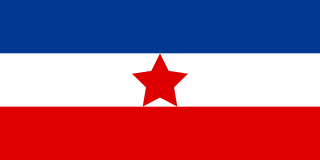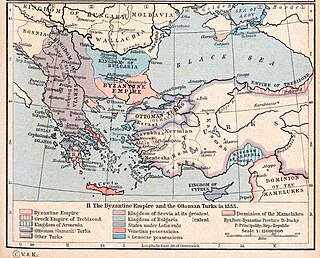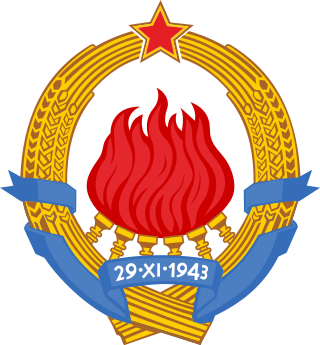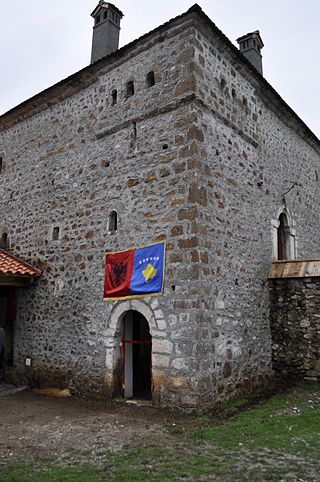 |
|---|
Parliamentary elections were held in the People's Republic of Serbia on 10 November 1946 to elect the 287 members of the constituent assembly. [1]
 |
|---|
Parliamentary elections were held in the People's Republic of Serbia on 10 November 1946 to elect the 287 members of the constituent assembly. [1]
The second session of the Anti-Fascist Council for the National Liberation of Yugoslavia held on 29 and 30 November 1943 resulted in a decision to form a federal Yugoslav state, each of which would have its own national assembly. In November 1944 a Great Anti-fascist People's Liberation Assembly was held in Serbia, with 989 delegates nominated by the People's Liberation Committees and the People's Liberation Front. [2] The delegates elected 278 members from amongst themselves to form the Anti-fascist Assembly of People's Liberation of Serbia. [2] In April 1945 the Assembly was renamed the National Assembly of Serbia. [2]
Prior to the elections taking place, the National Assembly passed an electoral law in July 1946. [2]
Of the 3,776,615 registered voters, 3,428,507 (91%) voted. [1] Nine women were elected. [2]
The National Assembly produced and adopted a new constitution, promulgating it on 17 January 1947. [2]

Democratic Federal Yugoslavia, also known as Democratic Federative Yugoslavia, was a provisional state established during World War II on 29 November 1943 through the Second Session of the Anti-Fascist Council for the National Liberation of Yugoslavia (AVNOJ). The National Committee for the Liberation of Yugoslavia (NKOJ) was its original executive body. Throughout its existence it was governed by Marshal Josip Broz Tito as prime minister.
The Anti-Fascist Council for the National Liberation of Yugoslavia, commonly abbreviated as the AVNOJ, was a deliberative and legislative body that was established in Bihać, Yugoslavia, in November 1942. It was established by Josip Broz Tito, the leader of the Yugoslav Partisans, an armed resistance movement led by the Communist Party of Yugoslavia to resist the Axis occupation of the country during World War II.

The Yugoslav Partisans, or the National Liberation Army, officially the National Liberation Army and Partisan Detachments of Yugoslavia, was the communist-led anti-fascist resistance to the Axis powers in occupied Yugoslavia during World War II. Led by Josip Broz Tito, the Partisans are considered to be Europe's most effective anti-Axis resistance movement during World War II.

The Socialist Republic of Bosnia and Herzegovina, commonly referred to as Socialist Bosnia or simply Bosnia, was one of the six constituent federal states forming the Socialist Federal Republic of Yugoslavia. It was a predecessor of the modern-day Bosnia and Herzegovina, existing between 1945 and 1992, under a number of different formal names, including Democratic Bosnia and Herzegovina (1943–1946) and People's Republic of Bosnia and Herzegovina (1946–1963).

The prime minister of Yugoslavia was the head of government of the Yugoslav state, from the creation of the Kingdom of Serbs, Croats and Slovenes in 1918 until the breakup of the Socialist Federal Republic of Yugoslavia in 1992.

The Socialist Republic of Serbia, previously known as the People's Republic of Serbia, commonly abbreviated as Republic of Serbia, was one of the six constituent republics of the Socialist Federal Republic of Yugoslavia in what is now the modern day states of Serbia and the disputed territory of Kosovo. Its formation was initiated in 1941, and achieved in 1944–1946, when it was established as a federated republic within Yugoslavia. In that form, it lasted until the constitutional reforms from 1990 to 1992, when it was reconstituted, as the Republic of Serbia within the Federal Republic of Yugoslavia. It was the largest constituent republic of Yugoslavia, in terms of population and territory. Its capital, Belgrade, was also the federal capital of Yugoslavia.

Dr. Nikola "Niko" Miljanić was a Montenegrin and Serbian anatomist and surgeon, professor of anatomy at Belgrade Medical School, resistance participant during World War II and the president of Montenegrin wartime Assembly.

The Anti-fascist Assembly for the National Liberation of Serbia was formed in November 1944, as the governing body of the Yugoslav National-Liberation Movement in the newly liberated Serbia. President of ASNOS was Siniša Stanković.
The State Anti-fascist Council for the National Liberation of Bosnia and Herzegovina, commonly abbreviated as the ZAVNOBiH, was convened on 25 November 1943 in Mrkonjić Grad during the World War II Axis occupation of Yugoslavia. It was established as the highest representative and legislative body in the territory of Bosnia and Herzegovina under control of the Yugoslav Partisans.

The Parliament of Yugoslavia was the legislature of Yugoslavia. Before World War II in the Kingdom of Yugoslavia it was known as the National Assembly, while in the Socialist Federal Republic of Yugoslavia the name was changed to Federal Assembly. It functioned from 1920 to 1992 and resided in the building of the House of the National Assembly which subsequently served as the seat of the Parliament of Serbia and Montenegro and since 2006 hosts the National Assembly of Serbia. The Federal Assembly was the highest organ of state power and the only branch of government in the country, with all state organs subservient to it under the principle of unified power as it was a one-party state, with the League of Communists of Yugoslavia as the sole legal party in the country. Most of the Federal Assembly's actions simply rubber stamp the party's decisions.

The Socialist Alliance of Working People of Yugoslavia (SSRNJ), known before 1953 as the People's Front of Yugoslavia (NFJ), was the largest and most influential mass organization in SFR Yugoslavia from August 1945 through 1990. It succeeded the Unitary National Liberation Front, which gathered and politically backed anti-fascist layers of society throughout Yugoslavia since 1934. By 1990, SSRNJ's membership was thirteen million individuals, including most of the adult population of the country. Together with the League of Communists of Serbia, it merged in July 1990 to form the Socialist Party of Serbia.

The president of the National Assembly of Serbia is the presiding officer of the National Assembly of Serbia. The president is elected by members of each new assembly for a term lasting four years.

Elections were held on municipal, provincial, republican and federal levels in Yugoslavia from its foundation in 1918 throughout its breakup in 1992.

The Assembly of the Delegates of the Slovene Nation or the Kočevje Assembly was the session held in Kočevje in what is now southern Slovenia over the period 1–3 October 1943 by the highest representative body of the anti-fascist Partisan movement in Slovenia during World War II. The assembly elected the legislative body of the Slovene liberated areas.

The Croatian Partisans, officially the National Liberation Movement in Croatia, were part of the anti-fascist National Liberational Movement in the Axis-occupied Yugoslavia which was the most effective anti-Nazi resistance movement. It was led by Yugoslav revolutionary communists during the World War II. NOP was under the leadership of the League of Communists of Yugoslavia (KPJ) and supported by many others, with Croatian Peasant Party members contributing to it significantly. NOP units were able to temporarily or permanently liberate large parts of Croatia from occupying forces. Based on the NOP, the Federal Republic of Croatia was founded as a constituent of the Democratic Federal Yugoslavia. British Prime Minister Winston Churchill referred to the movement as "the Croatian miracle".

Siniša Stanković was a Yugoslav and Serbian scientist and politician. As a prominent biologist, he became member of the Serbian Academy of Sciences and Arts. As a politician and statesman, from 1944 to 1946, he was the most senior state official of Serbia, then a federated state within Yugoslavia, and thus considered as the 1st President of Serbia as the President of the Presidium of the People's Assembly of Serbia.
Constitutional Assembly elections were held in the Socialist Republic of Montenegro on 3 November 1946. They were the first elections in Montenegro in which women had the right to vote, and three women were elected to the Assembly; Lidija Jovanović, Dobrila Ojdanić and Draginja Vušović.

The Bujan Conference was a political assembly held between December 31st, 1943 and January 2nd, 1944 in Bujan, a village in the Highlands of Gjakova. It was attended by 49 delegates from the Communist Party of Albania and the Communist Party of Yugoslavia. The organization of the conference was fueled by the main political goal among Kosovo Albanians in that era which was self-determination and reunification of Kosovo with Albania.The main resolution voted in Bujan called for the unification of the Socialist Republic of Albania and Kosovo after the end of WWII. The resolution of Bujan was abandoned after German retreat from the Balkans. Kosovo remained part of Yugoslavia, as an autonomous region of SR Serbia. The first uprising against the new Yugoslav regime began in late 1944, a few weeks after Yugoslav leadership made it clear that the unification of Kosovo with Albania would not occur after the war.